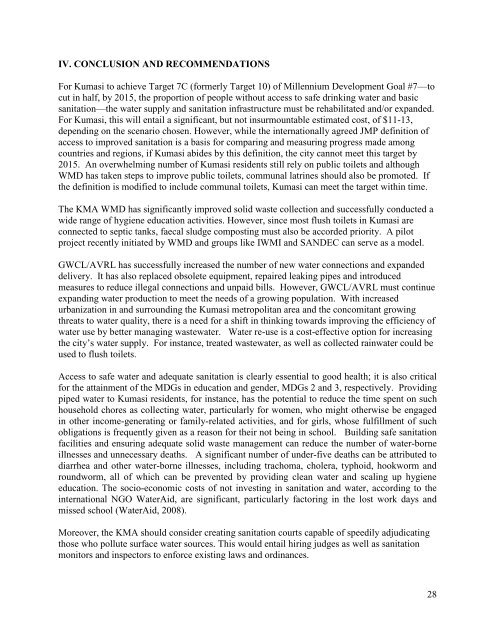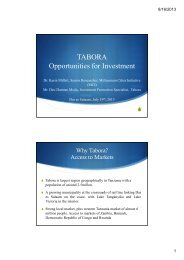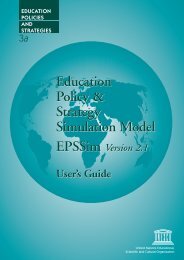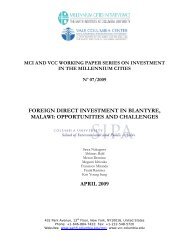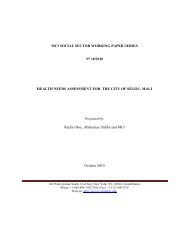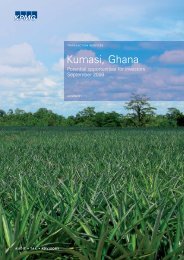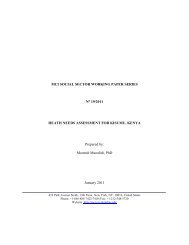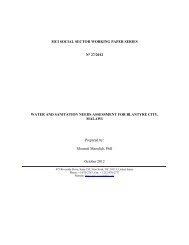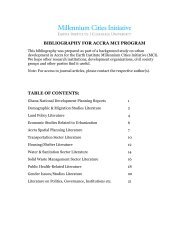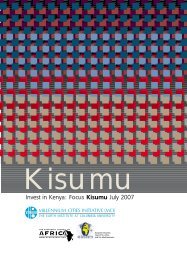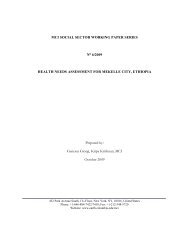A Water and Sanitation Needs Assessment for Kumasi, Ghana
A Water and Sanitation Needs Assessment for Kumasi, Ghana
A Water and Sanitation Needs Assessment for Kumasi, Ghana
You also want an ePaper? Increase the reach of your titles
YUMPU automatically turns print PDFs into web optimized ePapers that Google loves.
IV. CONCLUSION AND RECOMMENDATIONS<br />
For <strong>Kumasi</strong> to achieve Target 7C (<strong>for</strong>merly Target 10) of Millennium Development Goal #7—to<br />
cut in half, by 2015, the proportion of people without access to safe drinking water <strong>and</strong> basic<br />
sanitation—the water supply <strong>and</strong> sanitation infrastructure must be rehabilitated <strong>and</strong>/or exp<strong>and</strong>ed.<br />
For <strong>Kumasi</strong>, this will entail a significant, but not insurmountable estimated cost, of $11-13,<br />
depending on the scenario chosen. However, while the internationally agreed JMP definition of<br />
access to improved sanitation is a basis <strong>for</strong> comparing <strong>and</strong> measuring progress made among<br />
countries <strong>and</strong> regions, if <strong>Kumasi</strong> abides by this definition, the city cannot meet this target by<br />
2015. An overwhelming number of <strong>Kumasi</strong> residents still rely on public toilets <strong>and</strong> although<br />
WMD has taken steps to improve public toilets, communal latrines should also be promoted. If<br />
the definition is modified to include communal toilets, <strong>Kumasi</strong> can meet the target within time.<br />
The KMA WMD has significantly improved solid waste collection <strong>and</strong> successfully conducted a<br />
wide range of hygiene education activities. However, since most flush toilets in <strong>Kumasi</strong> are<br />
connected to septic tanks, faecal sludge composting must also be accorded priority. A pilot<br />
project recently initiated by WMD <strong>and</strong> groups like IWMI <strong>and</strong> SANDEC can serve as a model.<br />
GWCL/AVRL has successfully increased the number of new water connections <strong>and</strong> exp<strong>and</strong>ed<br />
delivery. It has also replaced obsolete equipment, repaired leaking pipes <strong>and</strong> introduced<br />
measures to reduce illegal connections <strong>and</strong> unpaid bills. However, GWCL/AVRL must continue<br />
exp<strong>and</strong>ing water production to meet the needs of a growing population. With increased<br />
urbanization in <strong>and</strong> surrounding the <strong>Kumasi</strong> metropolitan area <strong>and</strong> the concomitant growing<br />
threats to water quality, there is a need <strong>for</strong> a shift in thinking towards improving the efficiency of<br />
water use by better managing wastewater. <strong>Water</strong> re-use is a cost-effective option <strong>for</strong> increasing<br />
the city’s water supply. For instance, treated wastewater, as well as collected rainwater could be<br />
used to flush toilets.<br />
Access to safe water <strong>and</strong> adequate sanitation is clearly essential to good health; it is also critical<br />
<strong>for</strong> the attainment of the MDGs in education <strong>and</strong> gender, MDGs 2 <strong>and</strong> 3, respectively. Providing<br />
piped water to <strong>Kumasi</strong> residents, <strong>for</strong> instance, has the potential to reduce the time spent on such<br />
household chores as collecting water, particularly <strong>for</strong> women, who might otherwise be engaged<br />
in other income-generating or family-related activities, <strong>and</strong> <strong>for</strong> girls, whose fulfillment of such<br />
obligations is frequently given as a reason <strong>for</strong> their not being in school. Building safe sanitation<br />
facilities <strong>and</strong> ensuring adequate solid waste management can reduce the number of water-borne<br />
illnesses <strong>and</strong> unnecessary deaths. A significant number of under-five deaths can be attributed to<br />
diarrhea <strong>and</strong> other water-borne illnesses, including trachoma, cholera, typhoid, hookworm <strong>and</strong><br />
roundworm, all of which can be prevented by providing clean water <strong>and</strong> scaling up hygiene<br />
education. The socio-economic costs of not investing in sanitation <strong>and</strong> water, according to the<br />
international NGO <strong>Water</strong>Aid, are significant, particularly factoring in the lost work days <strong>and</strong><br />
missed school (<strong>Water</strong>Aid, 2008).<br />
Moreover, the KMA should consider creating sanitation courts capable of speedily adjudicating<br />
those who pollute surface water sources. This would entail hiring judges as well as sanitation<br />
monitors <strong>and</strong> inspectors to en<strong>for</strong>ce existing laws <strong>and</strong> ordinances.<br />
28


